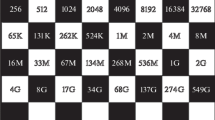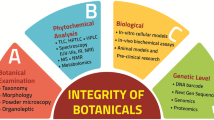Abstract
A comparative performance evaluation of DNA extraction methods from anti-diabetic botanical supplements using various commercial kits was conducted, to determine which produces the best quality DNA suitable for PCR amplification, sequencing and species identification. All plant materials involved were of suboptimal quality showing various levels of degradation and therefore representing real conditions for testing herbal supplements. Eight different DNA extraction methods were used to isolate genomic DNA from 13 medicinal plant products. Two methods for evaluation, DNA concentration measurements that included absorbance ratios as well as PCR amplifiability, were used to determine quantity and quality of extracted DNA. We found that neither DNA concentrations nor commonly used UV absorbance ratio measurements at A 260/A 280 between 1.7 and 1.9 are suitable for globally predicting PCR success in these plant samples, and that PCR amplifiablity itself was the best indicator of extracted product quality. However, our results suggest that A 260/A 280 ratios below about 1.3 and above 2.3 indicated a DNA quality too poor to amplify. Therefore, A 260/A 280 measurements are not useful to identify samples that likely will amplify but can be used to exclude samples that likely will not amplify reducing the cost for unnecessarily subjecting samples to PCR. The two Nucleospin® plant II kit extraction methods produced the most pure and amplifiable genomic DNA extracts. Our results suggest that there are clear, discernable differences between extraction methods for low quality plant samples in terms of producing contamination-free, high-quality genomic DNA to be used for further analysis.

Similar content being viewed by others
References
Chen, S., Yao, H., Han, J., Liu, C., Song, J., et al. (2010). Validation of the ITS2 region as a novel DNA Barcode for identifying medicinal plant species. PLoS ONE, 5(1), e8613.
Shane-McWhorter, L. (2009). Dietary supplements for diabetes: An evaluation of commonly used products. Diabetes Spectrum, 22(4), 206–213.
Spoor, D., Martineau, L. C., Leduc, C., Benhaddou-Andaloussi, A., Meddah, B., et al. (2006). Selected plant species for the cree pharmacopoeia of northern Quebec possess anti-diabetic potential. Canadian Journal of Physiology and Pharmacology, 84, 847–858.
Alonso-Castro, A. J., Miranda-Torres, A. C., González-Chávez, M. M., & Salazar-Olivo, L. A. (2008). Cecropia obtusifolia bertol and its active compound, chlorogenic acid, stimulate 2-NBD glucose uptake in both insulin-sensitive and insulin-resistant 3T3 adipocytes. Journal of Ethnopharmacology, 120(3), 458–464.
Feng, T., Liu, S., & He, X.-J. (2010). Molecular authentication of the traditional Chinese medicinal plant Angelica sinensis based on internal transcribed spacer of nrDNA. Electronic Journal of Biotechnology, 13(1).
Gao, T., Yao, H., Song, J., Liu, C., Zhu, Y., et al. (2010). Identification of medicinal plants in the family Fabaceae using a potential DNA barcode ITS2. Journal of Ethnopharmacology, 130(1), 116–121.
Novak, J., Grausgruber-Gröger, S., & Lukas, B. (2007). DNA-based authentication of plant extracts. Food Research International, 40(3), 388–392.
Ribeiro, R. A., & Lovato, M. B. (2007). Comparative analysis of different DNA extraction protocols in fresh and herbarium specimens of the genus Dalbergia. Genetics and Molecular Research, 6(1), 173–187.
Tapia-Tussell, R., Quijano-Ramayo, A., Rojas-Herrera, R., Larque-Saavedra, A., & Perez-Brito, D. (2005). A fast, simple, and reliable high-yielding method for DNA extraction from different plant species. Molecular Biotechnology, 31(2), 137–139.
Sarwat, M., Negi, M. S., Lakshmikumaran, M., Tyagi, A. K., Das, S., & Srivastava, P. S. (2006). A standardized protocol for genomic DNA isolation from Terminalia arjuna for genetic diversity analysis. Electronic Journal of Biotechnology, 9(1), 86–91.
Friar, E. A. (2005). Isolation of DNA from plants with large amounts of secondary metabolites. Methods in Enzymology, 395, 3–14.
Varma, A., Padh, H., & Shrivastava, N. (2007). Plant genomic DNA isolation: An art or a science. Biotechnology Journal, 2, 386–392.
Allen, G. C., Flores-Vergara, M. A., Krasnyanski, S., Kumar, S., & Thompson, W. F. (2005). A modified protocol for rapid DNA isolation from plant tissues using cetyltrimethylammonium bromide. Nature Protocols, 1(5), 2320–2325.
Sharma, P., Joshi, N., & Sharma, A. (2010). Isolation of genomic DNA from medicinal plants without liquid nitrogen. Indian Journal of Experimental Biology, 48, 610–614.
Pirttilä, A. M., Hirsikorpi, M., Kämäräinen, T., Jaakola, L., & Hohtola, A. (2001). DNA isolation methods for medicinal and aromatic plants. Plant Molecular Biology Reporter, 19, 273a–273f.
Vural, H. C. (2009). Genomic DNA isolation from aromatic and medicinal plants growing in Turkey. Scientific Research and Essay, 4(2), 059–064.
Shahzadi, I., Ahmed, R., Hassan, A., & Shah, M. M. (2010). Optimization of DNA extraction from seeds and fresh leaf tissues of wild marigold (Tagetes minuta) for polymerase chain reaction analysis. Genetics and Molecular Research, 9(1), 386–393.
Deshmukh, V. P., Thakare, P. V., Chaudhari, U. S., & Gawande, P. A. (2007). A simple method for isolation of genomic DNA from fresh and dry leaves of Terminalia arjuna (Roxb.) Wight and Argot. Electronic Journal of Biotechnology, 10(3).
Ahmed, I., Islam, M., Arshad, W., Mannan, A., Ahmad, W., & Mirza, B. (2009). High-quality plant DNA extraction for PCR: An easy approach. Journal of Applied Genetics, 50(2), 105–107.
Cimino, M. T. (2010). Successful isolation and PCR Amplification of DNA from national institute of standards and technology herbal dietary supplement standard reference material powders and extracts. Planta Medica, 76, 495–497.
Telle, S., & Thines, M. (2008). Amplification of cox2 (~620 bp) from 2 mg of up to 129 years old herbarium specimens, comparing 19 extraction methods and 15 polymerases. PLoS ONE, 3(10), e3584.
Drábková, L., Kirschner, J., & Vlcek, C. (2002). Comparison of seven DNA extraction and amplification protocols in historical herbarium specimens of Juncaceae. Plant Molecular Biology Reporter, 20, 161–175.
Demeke, T., & Ratnayaka, I. (2009). Effects of DNA extraction and purification methods on real-time quantitative PCR analysis of roundup ready® soybean. Journal of AOAC International, 92(4), 1136–1144.
Richardson, A., & King, W. K. (2009). Tournefortia hirsutissima (Boraginaceae) new to the flora of Texas. Journal of the Botanical Research Institute of Texas, 3(1), 465–467.
Andrade-Cetto, A., & Heinrich, M. (2005). Mexican plants with hypoglycaemic effect used in the treatment of diabetes. Journal of Ethnopharmacology, 99(3), 325–348.
Alarcon-Aguliar, F. J., Calzada-Bermejo, F., Hernandez-Galicia, E., Ruiz-Angeles, C., & Roman-Ramos, R. (2005). Acute and chronic hypoglycemic effect of Ibervillea sonorae root extracts-II. Journal of Ethnopharmacology, 97(3), 447–452.
Sánchez de Medina, F., Gámez, M. J., Jiménez, I., Jiménez, J., Osuna, J. I., & Zarzuelo, A. (1994). Hypoglycemic activity of juniper “berries”. Planta Medica, 60(3), 197–200.
Zavaleta, A., & Salinas, A., Jr. (2009). Curandero conversations: El niño fidencio, shamanism and healing traditions of the Borderlands. Bloomington: AuthorHouse.
Blattner, F. R. (1999). Direct amplification of the entire ITS region from poorly preserved plant material using recombinant PCR. BioTechniques, 27(6), 1180–1186.
Taberlet, P., Gielly, L., Pautou, G., & Bouvet, J. (1991). Universal primers for amplification of three non-coding regions of chloroplast DNA. Plant Molecular Biology, 17, 1105–1109.
Huie, C. W. (2002). A review of modern sample-preparation techniques for the extraction and analysis of medicinal plants. Analytical and Bioanalytical Chemistry, 373(1–2), 23–30.
Demeke, T., & Jenkins, G. R. (2010). Influence of DNA extraction methods, PCR inhibitors and quantification methods on real-time PCR assay of biotechnology-derived traits. Analytical and Bioanalytical Chemistry, 396(6), 1977–1990.
Doyle, J. J., & Doyle, J. L. (1987). A rapid DNA isolation procedure for small quantities of fresh leaf tissue. Phytochemical Bulletin, 19, 11–15.
Elbaum, R., Melamed-Bessudo, C., Boaretto, E., Galili, E., Lev-Yadun, S., et al. (2006). Ancient olive DNA in pits: Preservation, amplification and sequence analysis. Journal of Archaeological Science, 33, 77–88.
Townsend, J. A., Wright, D. A., Winfrey, R. J., Fu, F., Maeder, M. L., et al. (2009). High-frequency modification of plant genes using engineered zinc-finger nucleases. Nature, 459, 442–445.
Ray, J. D., Morel, W., Smith, J. R., Frederick, R. D., & Miles, M. R. (2009). Genetics and mapping of adult plant rust resistance in soybean PI 587886 and PI 587880A. Theoretical and Applied Genetics, 119(2), 271–280.
Dumbrell, A. J., Nelson, M., Helgason, T., Dytham, C., & Fitter, A. H. (2009). Idiosyncrasy and overdominance in the structure of natural communities of arbuscular mycorrhizal fungi: Is there a role for stochastic processes? Journal of Ecology, 98(2), 419–428.
Warburg, O., & Christian, W. (1942). Isolation and crystallization of enolase. Biochemische Zeitschrift, 310, 384–421.
Glasel, J. A. (1995). Validity of nucleic acid purities monitored by 260 nm/280 nm absorbance ratio. BioTechniques, 18(1), 62–63.
Manchester, K. L. (1995). Value of A260/A280 ratios for measurement of purity of nucleic acids. BioTechniques, 19(2), 208–210.
Acknowledgments
The authors would like to thank Dr. Julie Morris for all her help throughout this project. Funding for this project was partially provided by the National Institutes of Health MBRS-RISE Program (Grant 5R25 GM065925-06).
Author information
Authors and Affiliations
Corresponding author
Electronic Supplementary Material
Below is the link to the electronic supplementary material.
Rights and permissions
About this article
Cite this article
Llongueras, J.P., Nair, S., Salas-Leiva, D. et al. Comparing DNA Extraction Methods for Analysis of Botanical Materials Found in Anti-Diabetic Supplements. Mol Biotechnol 53, 249–256 (2013). https://doi.org/10.1007/s12033-012-9520-0
Published:
Issue Date:
DOI: https://doi.org/10.1007/s12033-012-9520-0




